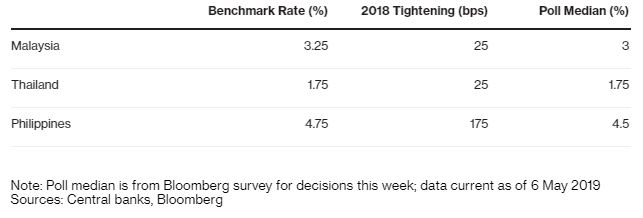To Cut or Hold: Southeast Asia Central Banks Face Busy Week
Southeast Asia’s central banks are taking a hard look at interest-rate cuts as global monetary policy turns more dovish, with Malaysia first in line with a possible move as soon as Tuesday.
It’s a busy week for the region’s policy makers with Bank Negara Malaysia’s decision followed by policy announcements from the Bank of Thailand on Wednesday and Bangko Sentral ng Pilipinas on Thursday.
Central banks are dialing back their hawkish stances of 2018, led by the Federal Reserve, which last week signaled it was firmly on hold from interest-rate action for the time being. With renewed drama in U.S.-China trade negotiations adding to economic risks, policy makers have fresh reason to consider accommodative stances if they see further disruptions to global and regional trade.
Southeast Asia Scorecard
Central banks facing decisions this week have varied interest-rate landscapes

Here’s how officials in Malaysia, Thailand and the Philippines will be mulling monetary policy this week:
Malaysia
- Tuesday, 3 p.m. in Kuala Lumpur
- Bloomberg survey: 25 basis point cut (14 out of 23 economists)
Economists are fairly split on Malaysia’s policy announcement, with a slim majority seeing policy makers going ahead with their first interest-rate action since a January 2018 hike.
The government is sticking to its 4.9 percent growth target for 2019 despite a weakening in global demand and a more subdued outlook from the central bank. Rising oil prices help the net energy exporter, while inflation remains benign.
Bigger worries, though, include souring investor confidence as the replacement of the goods-and-services tax last year has brought little in the way of a pledged boost to consumption. Delays and cancellations of major infrastructure projects and lack of progress in reducing the fiscal deficit also weigh on sentiment. The ringgit has depreciated against the dollar in 2019, and equities have remained one of the worst performers across Asia.
Alan Lau, an economist at Oversea-Chinese Banking Corp. in Singapore, sees Bank Negara opting to wait at least until July to make a move. The Malaysian central bankers have typically given strong signals for forthcoming rate actions and those messages have been absent this time, he said.
Thailand
- Wednesday, 2:05 p.m. in Bangkok
- Bloomberg survey: Hold (All 24 economists)
Thailand is the most likely to stay on hold of any of the three Southeast Asian central banks this week, with a unanimous Bloomberg poll for the third straight meeting.
Since raising the benchmark interest rate in December for the first policy change since 2015, the Bank of Thailand has seen the baht strengthen the most in Southeast Asia. That’s weighing on the export outlook at the same time the election gridlock is adding to investor uncertainty.
Burin Adulwattana, chief economist at Bangkok Bank Pcl, sees the central bank staying on hold for all of 2019 as growth prospects wither.
“The Bank of Thailand has been caught between a rock and a hard place,” said Burin. “They can’t raise the rate given the weak economic backdrop and they can’t cut the rate either given earlier hawkish stance.”
Governor Veerathai Santiprabhob is maintaining a cautious stance for now, telling economists last month that the Bank of Thailand hadn’t closed the door to more interest-rate hikes in this cycle. Inflation remains subdued at the lower end of the 1 percent to 3 percent target range.
Philippines
- Thursday, 4 p.m. in Manila
- Bloomberg survey: 25 bps cut (12 of 23 economists)
The Philippine central bankers are navigating a tricky balance between managing a plunge in inflation from last year’s nine-year high and the upward pressures from rising oil prices this year. Consumer-price growth slowed for a sixth month to 3 percent in April, government data showed Tuesday.
For Governor Benjamin Diokno, policy easing is “just a matter of time” as the central bank looks to unwind its 175 basis points’ worth of tightening last year and lower the reserve requirement ratio for banks.
“At the moment, we’re looking at possible monetary easing in light of the global trend,” Diokno said. “The U.S has stopped the normalization process, the same thing with Japan. That gives us a lot of bullets for monetary easing.”
Philippine central bankers last month had signaled a preference to see more of last year’s rate increases filter through to the economy before a reversal in 2019.
At the same time, the peso has appreciated more than 1 percent against the dollar so far this year, among the better performances in Asia. That gives the central bank some room to consider cuts to the benchmark interest rate, which has stood at 4.75 percent since the last hike in November.
Source: https://www.bloomberg.com/news/articles/2019-05-06/to-cut-or-hold-southeast-asia-central-banks-brace-for-busy-week


 Thailand
Thailand




